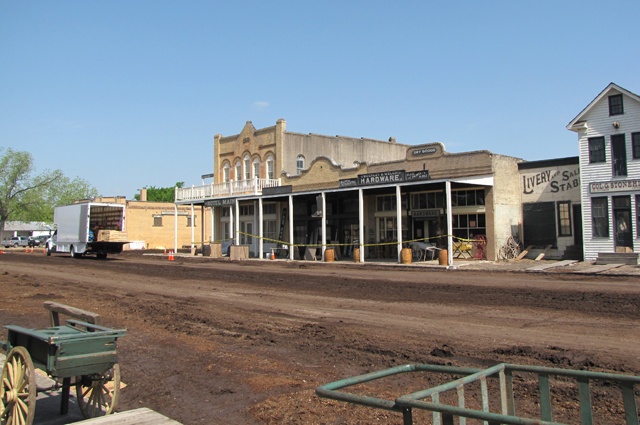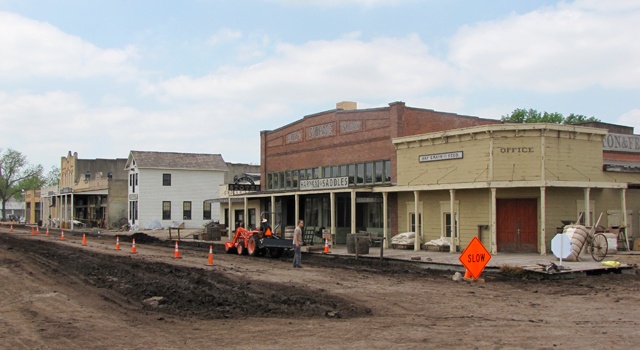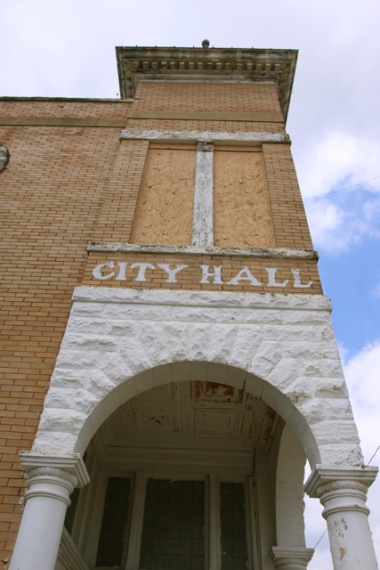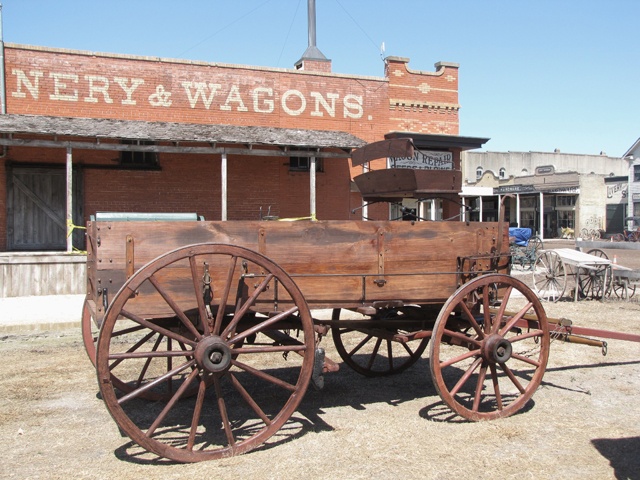What a fellowship, what a joy divine,
Leaning on the everlasting arms;
What a blessedness, what a peace is mine,
Leaning on the everlasting arms.
Leaning, leaning, safe and secure from all alarms;
Leaning, leaning, leaning on the everlasting arms.
Words by Elisha A. Hoffmann, 1887
Sung by Iris DeMent, “True Grit,” 2010
——————–
When the small Texas town of Granger was transformed into an early Fort Smith, Arkansas, for Paramount’s 2010 version of “True Grit,” it brought back memories for many, and a glimpse of yesteryear for those too young to remember. Eighty-three-year-old lifetime resident Bennie Bartosh relived Granger’s prosperous, bygone horse-and-buggy days through the eyes of Hollywood and watched historic Davilla Street come alive with all the hustle and bustle that was so much a part of his youth.
Born to a Czechoslovakian immigrant mother, Bartosh is a third-generation Grangerite. His father, Edmond, hammered his share of nails into the Granger National Bank, and his grandfather, O.R., helped build the Sts. Cyril and Methodius Catholic Church, whose steeple can be seen towering high above the trees as travelers on Texas Highway 95 approach town.
In 1882, when the first Czech settlers arrived, what is now Granger was known as Pollack. The area’s blackland property was cheap and fertile, making Williamson County a good location for homesteading. Granger became a thriving community, partly because the Missouri, Kansas and Texas railroads intersected there, creating a major shipping center for cotton. The Granger Gin was once among the largest in the United States.
A.W. Storrs, a merchant and owner of the First National Bank, built the Storrs Opera House in 1905. The opera house is no longer standing, but in its day, it offered a variety of entertainment and brought culture to the town’s population of approximately 850, a number that would double in 10 years.
Davilla Street divides the town, its west side still lined with the bricks that, in 1912, gave Granger the distinction of being the only town in Texas with a population of less than 5,000 to have a paved street. Brick streets became necessary during the booming business years of King Cotton’s reign, as folks upgraded their mode of transportation from horse and buggy to the automobile. Before paving the street with brick overlay, 100-foot-wide Davilla Street became a massive, muddy mess when the rains came—a circumstance totally unsuitable for a growing hub of early 20th century commerce.
“I remember back when I was a kid, [Davilla Street] was full of Model Ts and buggies; you couldn’t even find a parking place,” says Bartosh. “My first car was a Model T that my Daddy gave me. It didn’t have front fenders, or lights, so when I went out at night, I had to have moonlight.”
Many times, those Model Ts were parked in front of the local SPJST Hall. The sound of polkas and waltzes could be heard drifting through the open windows of the dance hall on the top floor—a promised reprieve from a hard day’s work. Bartosh says there was always a dance somewhere in the community every Wednesday, Friday, Saturday and Sunday nights. Bartosh and his wife of 60 years, Gloria, danced their way through their courting years and beyond: “We must have danced a million miles.”
Granger “had two or three doctors, two or three lawyers, a dentist and four or five cotton gins,” says Bartosh with a hint of melancholy, as he looks at Gloria. “Now we have one [gin].”
According to Bartosh, in its heyday, the town also had a bottling company, several grocery stores, a movie theater and a number of saloons where “you could find a domino game at any time of the day.”
Although times were hard during the Depression, Bartosh says they always had everything they needed to survive. “My daddy would go to the store and buy flour, sugar and salt—that’s about it. We raised all our hogs and beef; we had a garden. We ate pretty good, and we always had fried chicken and sausage.”
Even then, necessity was the mother of invention. “When we made the sausage, we had no iceboxes,” Bartosh recalls. “We’d just put the sausages in a crock and covered them with grease.”
Not so unlike the early days depicted in “True Grit,” Granger did have its occasional outlaw. Bartosh points to a building across the street from his downtown home and casually remembers, “When I was a kid, a guy came in and killed the sheriff and a deputy … I forgot whatever happened to him.”
According to local folklore, in 1934, World War I veteran Ludwig Cernock loaded a Luger pistol and headed to the home of a man who refused to pay Cernock for work he had done, only to find the man had died. Tempers flared in a confrontation with the family of the deceased, and Marshal Henry Lindsey was called. He took Cernock to the justice of the peace, where it was decided that he would be placed in the Williamson County Jail. In the heat of the moment, the quick-tempered, pistol-packing Cernock shot the marshal and his deputy. Keeping the gathering crowd at bay with his reloaded Luger, the assailant leaned against a telephone pole—a mere 100 feet from the dead bodies—and lit his pipe, supposedly to ponder what he had done. It was then that a schoolboy, “Maxie” Golf, brazenly hurled a window weight at the back of the murderer’s head, knocking him unconscious. Justice was swift; Cernock was electrocuted 90 days after the crime.
Those outlaw days of yesteryear are gone, and now, outside of an occasional train whistle, quiet is the order of the day.
Gone, too, are the days when, because of its importance as a commercial shipping point, trains passed through the town with unwavering predictability. Bartosh says, “One would come at eight in the morning, and one at four in the evening—we didn’t need a clock.”
For a lifetime, Bennie Bartosh has watched his hometown adjust to the inevitable changes brought about by the hands of time, but he has never wavered: “I tried it all. Granger is home … always.”
“True Grit” brought more than commerce, tourism and brief fame to the town; it brought memories. As Iris DeMent sings the traditional 19th century hymn, “Leaning on the Everlasting Arms,” the credits roll; the movie ends. Paramount has moved on, and taken with it, Fort Smith, Arkansas. Granger has returned to the 21st century.
At a city park on the east side of Davilla Street, swings blow lazily in the breeze, waiting for summer’s barefoot children to once again enjoy baseball, hot dogs and watermelon. Concrete lions representing Granger football’s mascot are scattered throughout the town, paying tribute to the time-honored Texas tradition of Friday night lights.
And Granger carries on, with a charm reminiscent of a weathered Rockwell print, long forgotten in someone’s dusty attic.
——————–
Connie Strong is a freelance writer based out of Chappell Hill, near Houston.




